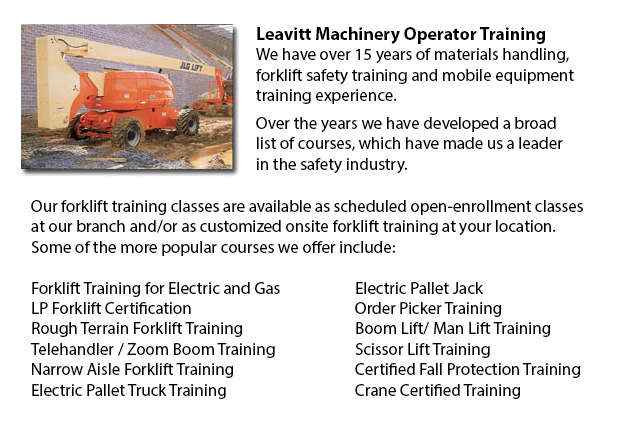
Aerial Boom Lift Training Burlington - Aerial Boom Lift Training is necessary for any person who supervises, operates or works in the vicinity of boom lifts. This particular type of aerial lift or aerial work platform is utilized for lifting people, materials and tools in projects requiring a long reach. They are normally used to access utility lines and other above ground job-sites. There are various types of aerial booms lifts, such as extension boom lifts, cherry pickers and articulating boom lifts. There are two kinds of boom lift: "telescopic" and "knuckle".
Training in the essential safety, operations and equipment concerns involved in boom lifts is vital. Workers must know the dangers, safe work practices and rules when working among mobile equipment. Training course materials offer an introduction to the applications, terms, skills and concepts needed for workers to obtain competence in boom lift operation. The material is aimed at safety experts, workers and machine operators.
This training is adaptive, cost-effective and educational for your company. A safe and effective workplace can help a company attain overall high levels of production. Less workplace accidents happen in workplaces with strict safety policies. All equipment operators must be trained and evaluated. They need knowledge of present safety measures. They should comprehend and adhere to rules set forth by the local governing authorities and their employer.
It is the responsibility of the employer to make certain that workers who are required to utilize boom lifts are trained in their safe use. Each different type of workplace equipment requires its own equipment operator certification. Certifications are offered for aerial work platforms, articulating booms, industrial forklift trucks, scissor lifts, etc. Completely trained workers work more efficiently and effectively compared to untrained personnel, who require more supervision. Correct instruction and training saves resources in the long run.
Training is the best prevention for the primary reasons for workplace fatalities: falls, electrocutions and collapses or tip overs. Other than training, the best way to avoid workplace accidents is to operate and maintain aerial work platforms based on the manufacturer's instructions. Allow for the total weight of the materials, worker and tools when following load limits. Never override hydraulic, mechanical or electrical safety devices. Workers should be securely held inside the basket with a body harness or restraining belt with an attached lanyard. Do not move lift machinery whilst workers are on the elevated platform. Workers should take care not to position themselves between the beams or joists and basket rails in order to avoid being crushed. Energized overhead power lines must be at least 10 feet away from the lift machinery. It is suggested that workers always assume power lines and wires might be energized, even if they are down or seem to be insulated. If working on an incline, set brakes and use wheel chocks.
-
Order Picker Training Burlington
Order Picker Training Burlington - Order picker's enables warehouse employees to lift pallets using forks. Also called a stock picker, this particular electrically-powered equipment is similar to a forklift except that an order picker is likewise uti... More -
Crane Certification Burlington
Crane Certification Burlington - The Crane Certification training program includes content recommended by industry regarding the efficient and safe operation of cranes. Trainees would learn the following: how to identify cranes and their component pa... More -
Overhead Crane Training Burlington
Overhead Crane Training Burlington - The overhead crane is a piece of equipment which can lift and move huge, heavy objects which can't be handled by hands. Typically, overhead cranes are fixed in place. These equipment are capable of moving huge vol... More -
Aerial Lift / Boom Lift / Man Lift / Scissor Lift Training in Burlington
Lift tables or scissor lifts could elevate both people and goods vertically. They are normally used in construction, commercial and industrial environments. Commonly, the use of a scissor lift is to lift and lower supplies from one floor of a job loc... More -
Telehandler Operator Training Burlington
Telehandler Operator Training Burlington - Telescopic Handler forklifts or telehandler forklifts are usually found on construction places and their popularity continues to rise. The versatility of telehandler forklifts ensures that they are a valuabl... More -
Forklift Training Classes Burlington
Forklift Training Classes Burlington - Forklift are heavy pieces of industrial machines that are made use of in transporting and the handling of merchandise and materials. They are often known as Lift trucks and are found in all sorts of businesses.... More -
Boom Lift Training Burlington
Boom Lift Training Burlington - Aerial platforms or also known as elevated work platforms are devices that allow workers to perform tasks and duties at elevated heights that would not be otherwise accessible. There are a variety of aerial lifts avail... More -
Bucket Truck Training Burlington
Bucket Truck Training Burlington - The Vehicle-Mounted Aerial Work Platform or also called bucket truck training program is intended to decrease the risk of incident and personal injury while working in close proximity or with bucket trucks by effici... More

Forklift Training Burlington
TOLL FREE: 1-888-254-6157
Burlington, Ontario
forklifttrainingburlington.com
Email Us
About Us


